
Following our previous visit to New York-based Oza Sabbeth Architects, we are moving our Meet Your Next Employer series to California this week to explore the work of Walker Warner.
Founded in 1989, and based in San Francisco, the firm has built an extensive portfolio of bespoke homes and hospitality venues across the United States. “Enduring architecture gains beauty as it passes from one generation to the next. It is timeless,” the firm says about its ethos. “Thoughtful design heightens your way of life. It invites you to feel at ease, at peace, at home.”
Over on Archinect Jobs, the firm is currently hiring for several positions to join their San Francisco office. For candidates interested in applying for a position, or anybody interested in learning more about the firm’s output, we have rounded up five Hawaiian residential retreats by Walker Warner that exemplify the firm’s ethos.
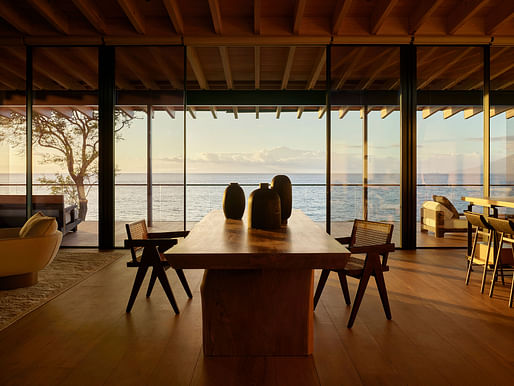
The Makena residence on Maui was designed to “balance openness with privacy, and sunlight with shadow.” While the street side of the house manifests as a modest, single-story structure with a board-formed concrete wall wrapping the courtyard, the opposite side reveals a two-story program constructed of glass and steel. To shelter the sea-facing living areas and bedrooms from both storms and tropical sun, ten-foot roof overhangs and sliding screens have been incorporated into the facade.
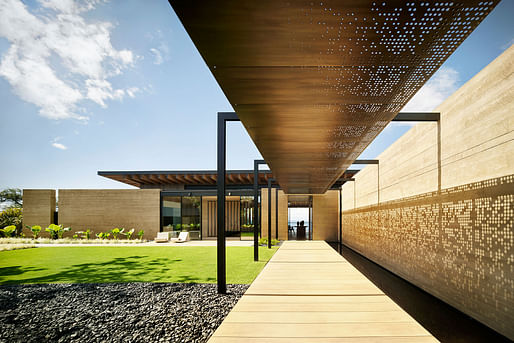
“Draped from the roof are two copper mesh rain screens that direct rainwater runoff,” the firm explains. “Inside, the Hawaiian ocean breeze flows through the large sliding glass doors, assisted by ceiling fans to maximize natural ventilation and minimize energy use. These measures and more, taken together, culminate in a building that harnesses the elements and achieves a LEED Silver certification for its sustainable design strategies.”
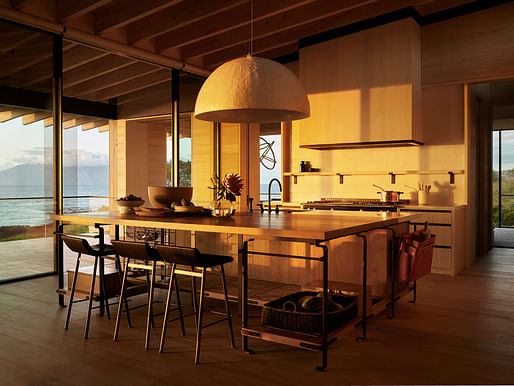
Situated on Kona’s coastline, Kua Bay was designed as a family retreat that embodied the various natural features visible from the site, including volcanic lava, mountains, and the sea. On the mountain-facing elevation, a driveway cuts through 15-foot-high lava rock formations that shield the property from surrounding neighbors and the roadway. Meanwhile, decorative corten steel panels screen the autocourt from the rest of the property. On the ocean side, floor-to-ceiling pocketing glass doors and wood screens are incorporated to soften the sunlight without compromising ocean views.
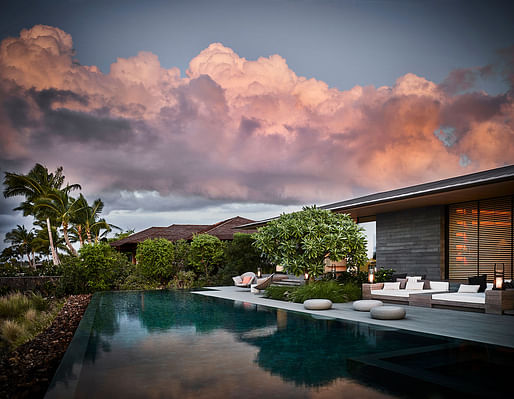
“Materials—including basalt, Alaska Yellow Cedar, and steel—are simple, tailored and unadorned, and used for both interior and exterior surfaces,” the firm explains. “Furnishings are casual, favoring lightly-colored sofas and chairs that act as a counterpoint to the dark lava and basalt. An ocean-facing lanai descends to an infinity-edge pool with intimate outdoor gathering spaces.”
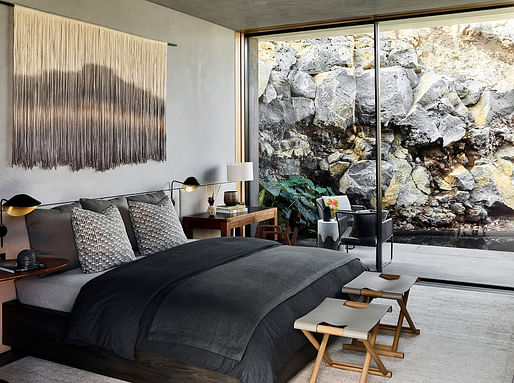
Hale Mau’u is constructed on a 2.9-acre site, accessed via a long driveway to create “an illusion of isolation.” A single raised boardwalk floats above the ground to form a linear axis towards the home, linking a series of long low buildings loosely clustered like a village. Anchoring the site is a courtyard and swimming pool which creates views of the ocean and island of Maui.

“Perhaps the most striking and original visual element of the project is the roofs, which are long gables with eaves designed to be narrow at one end of the building but wide at the other, carefully oriented to provide extra shade where it is most needed,” the team explains. “The roof cladding material is copper with standing seams, but laid up in random widths. This technique converts the appearance from something fairly common and utilitarian to something intriguing and vaguely organic, which Warner describes as being similar in texture to the trunk of a coconut palm.”

Designed as an open, casual beach retreat, Hale Nukumoi comprises a main house, guest house, large yard, pool, and beach access. An indoor/outdoor lifestyle is created by large sliding doors and walls, a custom two-story rain-screen, and layered plantings to balance connections between nature and privacy. Arranged as L-shaped structures, the main house and adjacent guest house feature pigmented, board-formed concrete base structures, with dark timber cladding the upper portions. Low-pitched roofs reach out to provide deep overhangs offering semi-protected transition spaces between inside to outside.
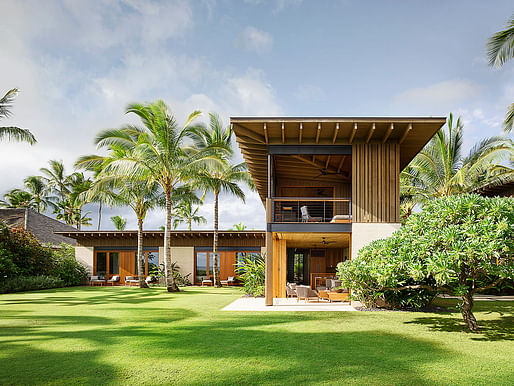
“Sand-colored floors and walls run through the interior, with ceilings and cabinetry clad in wood to match the ceiling beams,” the team explains. “Sand, volcanic rock, and trees come together to establish a subdued and sophisticated palette of materials and colors respectful of the geological and cultural history of the islands.”
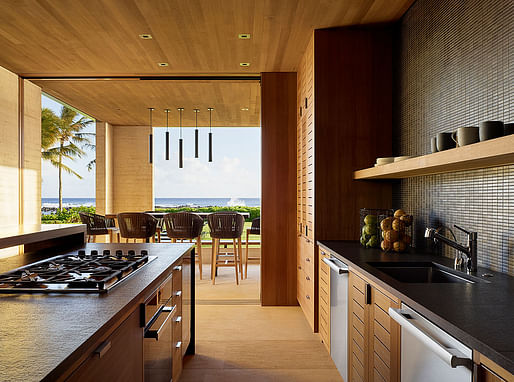
Makani Eka is set atop a hardened lava flow on the island of Kona, designed as a family compound that “strikes a balance between modernity and tradition.” Composed of four independent structures, including a cedar-clad main living pod, the architecture of the retreat is modern while relying heavily on traditional materials and references. Traditional Hawaiian villages, typically organized in loose clusters, inspired both the 1.5-acre site plan and the architectural style, as well as elements such as canted steel columns, steep-pitched roofs, and rhomboidal window and door openings.
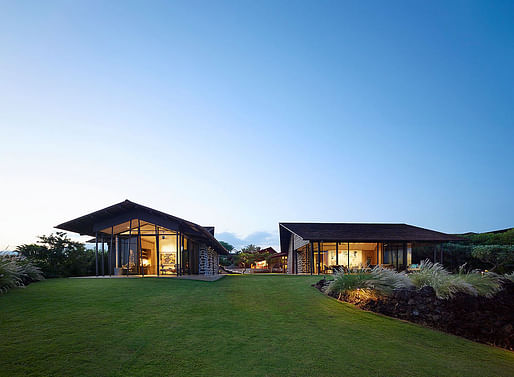
“The use of heavily mortared lava rock was inspired by the historic Mokuaikaua Church, located in nearby Kailua,” the team explains. “Windows are framed in stained sapele mahogany. Western red cedar serves as the dominant wood—both for cladding and the roof shingles—since it resists heat, moisture, and insects. Inside, stained and lightly polished concrete flooring keeps things cool during the day.”

Meet Your Next Employer is one of a number of ongoing weekly series showcasing the opportunities available on our industry-leading job board. Our Job Highlights series looks at intriguing and topical employment opportunities currently available on Archinect Jobs, while our weekly roundups curate job opportunities by location, career level, and job description.
No Comments
Block this user
Are you sure you want to block this user and hide all related comments throughout the site?
Archinect
This is your first comment on Archinect. Your comment will be visible once approved.